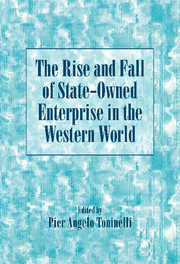Book contents
- Frontmatter
- Contents
- Preface
- Contributors
- PART I SETTING THE STAGE
- PART II NATIONAL CASES
- 5 The Rise and Fall of State-Owned Enterprise in Germany
- 6 Beyond State and Market: Italy's Futile Search for a Third Way
- 7 State Enterprise in Britain in the Twentieth Century
- 8 The Rise and Decline of State-Owned Industry in Twentieth-Century France
- 9 The Rise and Decline of Spanish State-Owned Firms
- 10 Fifty Years of State-Owned Industry in Austria, 1946–1996
- 11 A Reluctant State and Its Enterprises: State-Owned Enterprises in the Netherlands in the “Long” Twentieth Century
- 12 State-Owned Enterprises in a Hostile Environment: The U.S. Experience
- Conclusion: Schumpeter Revisited
- Index
8 - The Rise and Decline of State-Owned Industry in Twentieth-Century France
Published online by Cambridge University Press: 05 December 2011
- Frontmatter
- Contents
- Preface
- Contributors
- PART I SETTING THE STAGE
- PART II NATIONAL CASES
- 5 The Rise and Fall of State-Owned Enterprise in Germany
- 6 Beyond State and Market: Italy's Futile Search for a Third Way
- 7 State Enterprise in Britain in the Twentieth Century
- 8 The Rise and Decline of State-Owned Industry in Twentieth-Century France
- 9 The Rise and Decline of Spanish State-Owned Firms
- 10 Fifty Years of State-Owned Industry in Austria, 1946–1996
- 11 A Reluctant State and Its Enterprises: State-Owned Enterprises in the Netherlands in the “Long” Twentieth Century
- 12 State-Owned Enterprises in a Hostile Environment: The U.S. Experience
- Conclusion: Schumpeter Revisited
- Index
Summary
The question of public enterprise, especially state-owned and state-controlled enterprise, is crucial in contemporary French history. France witnessed three peaks in nationalization under left-wing governments (1936–7, 1945–6, 1982) and had an earlier tradition of state-created, state-owned, and state-controlled firms. By the early 1980s the state was involved in all major industries, including energy, machine tools, glass, car manufacturing, chemicals, Pharmaceuticals, shipping, banking, insurance, and aircraft manufacturing. More than 90 percent of energy production (electricity, gas, oil, coal), 75 percent of insurance and banking, and 35 percent of industrial production (including 45 percent of car manufacturing, 90 percent of aircraft and jet engine manufacturing, and 60 percent of telecommunications) belonged to public firms. Only a few industries were completely independent of public firms: retailing, food, clothing, and newspapers.
This achievement in the public economy contrasted with the huge and rapid turn toward privatization that took place beginning in 1986–7. Over a ten-year period, the state sold many of the firms that had been nationalized in 1944–6 or 1982–3. Even some of the firms that had been established or nationalized by the state before the socialist-inspired nationalization program of 1936 were returned to private ownership – for example, tobacco production. There has been a considerable public debate about the advantages and disadvantages of both nationalization and privatization. The performance of state-owned enterprises (SOEs), by both micro- and macroeconomic criteria, has been discussed widely. Experts have contributed many reports and books to the argument about how best to manage SOEs. Although France had previously been a homeland for the public sector, attitudes changed very quickly in the second half of the 1980s.
- Type
- Chapter
- Information
- The Rise and Fall of State-Owned Enterprise in the Western World , pp. 185 - 207Publisher: Cambridge University PressPrint publication year: 2000
- 11
- Cited by

